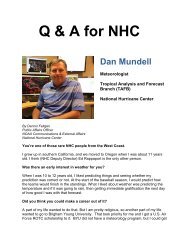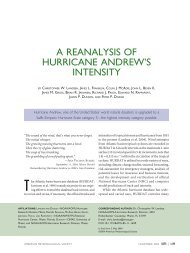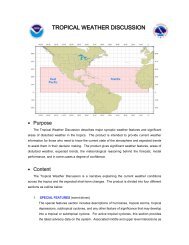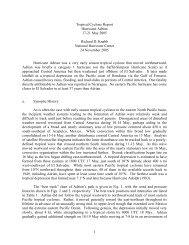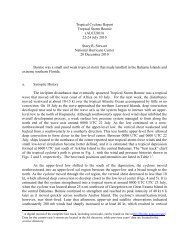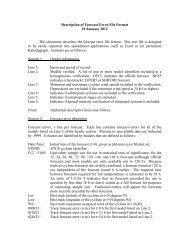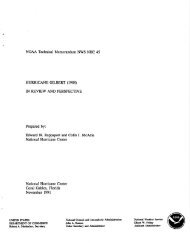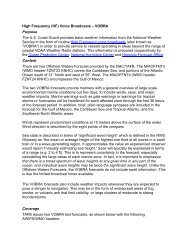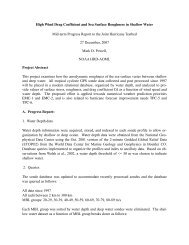the deadliest, costliest, and most intense united states hurricanes ...
the deadliest, costliest, and most intense united states hurricanes ...
the deadliest, costliest, and most intense united states hurricanes ...
Create successful ePaper yourself
Turn your PDF publications into a flip-book with our unique Google optimized e-Paper software.
10 ) How long has it been since a hurricane or a major hurricane hit a given communif.'"?<br />
A chronological list of all <strong>hurricanes</strong> to strike <strong>the</strong> United States 1900 through 1990 including<br />
month, <strong>states</strong> affected by category, <strong>and</strong> minimum sea level pressure at l<strong>and</strong>fall can be found in<br />
Jarrell et al. (1992). Table 11 extends that listing through 2000. Table 12 summarizes <strong>the</strong><br />
occurrence of <strong>the</strong> last major hurricane or of any hurricane to directly hit <strong>the</strong> more populated<br />
coastal communities from Brownsville, Texas to Eastport, Maine. In addition. if a hurricane<br />
indirectly affected a community:gf!g <strong>the</strong> last direct hit, it is listed in <strong>the</strong> last column of <strong>the</strong> table.<br />
In order to obtain <strong>the</strong> same type of information listed in Table 12 for <strong>the</strong> remaining coastal<br />
communities, <strong>the</strong> reader is again referred to Jarrell et al. (1992).<br />
Table 11 C hronologicallist of all <strong>hurricanes</strong> which affected <strong>the</strong> U.S. 1991-1999. including<br />
category by state. This is a continuation of a comparable table covering <strong>the</strong> years 1900-<br />
1990 given in Jarrell et al (1992)<br />
There many illustrative examples of <strong>the</strong> uncertainty of when a hurricane might strike a given<br />
locality. After a period of nearly 70 years without a direct hit, Pensacola, Florida was hit directly<br />
by hurricane Erin <strong>and</strong> indirectly by major hurricane Opal during a two month period in 1995.<br />
Miami, which expects a major hurricane every nine years, on average, was struck by a major<br />
hurricane in 1992 for <strong>the</strong> first time since 1950. Tampa hasn't experienced a major hurricane<br />
since 1921 years. Many locations along <strong>the</strong> Gulf <strong>and</strong> Atlantic coasts have not experienced a<br />
major hurricane during <strong>the</strong> period 1900-2000 (see Table 12).<br />
(11) What is <strong>the</strong> total United States damage (before <strong>and</strong> after adjustment for inflation) <strong>and</strong><br />
death toll for each year since 1900? Table 13 summarizes this infonnation. Table 13a ranks<br />
<strong>the</strong> top 30 years by deaths, by unadjusted damage <strong>and</strong> by adjusted damage. In <strong>most</strong> years <strong>the</strong><br />
death <strong>and</strong> damage totals are <strong>the</strong> result of a single, major hurricane. Gentry (1966) gives damages<br />
adjusted to 1957-59 costs as a base for <strong>the</strong> period 1915-1965. For <strong>the</strong> <strong>most</strong> part, death <strong>and</strong><br />
damage totals for <strong>the</strong> period 1915-1965 were taken from Gentry's paper, <strong>and</strong> for <strong>the</strong> remaining<br />
years from <strong>the</strong> Monthly Wea<strong>the</strong>r Review. Adjusted damages were converted to 2000 dollars by<br />
<strong>the</strong> factors used in Table 3a.<br />
17




